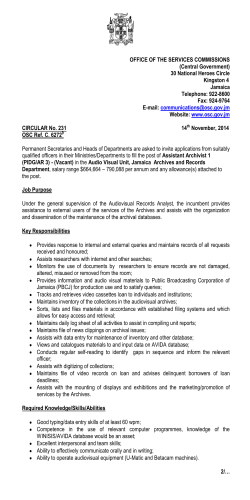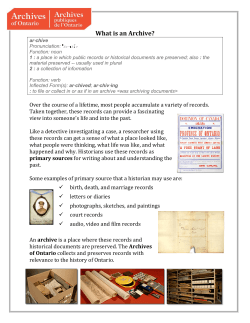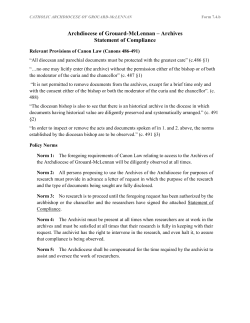
Volume 14 Number 1 - Syracuse University
University Archives / A Division of the Syracuse University Libraries ccess Vol. 14 No. 1 Spring 2015 FROM the DIRECTOR Archives has nearly 7,000 items listed in our audiovisual collection, including films, sound recordings, videotapes, audio tapes, CDs and more. But we estimate we hold another 10,000 or more scattered throughout our 1,100 other collections. So what do all these numbers mean? There are two ever-present problems with audiovisual materials. The first is the preservation issue of how long the physical media will actually last. The second is the knowledge that the equipment needed to play the media may not be available in the future or even now. How many of you still have a floppy drive on your computer? We are well into the digital age now with expectations that everything we hold will be digitized and available on the web. With over 18,000 boxes of records that’s an impossible task, but we are making strides. We have scanned over 9,400 images since 2007, but with a collection of 750,000 photos we still have a long way to go. Scanning a print is one thing, we can handle most in-house, but digitizing a 60-year-old film is another thing entirely. It is difficult, timeconsuming, and expensive. So to get a handle on our audiovisual materials we are beginning with a media census. We will do a physical inventory of every box likely to contain media and record the type, volume, and the physical condition. We started with film reels as a test and already located a few that we identified as “at risk” because of their deteriorating condition. Our charge is to preserve records that document the history of Syracuse University, and to make those records available for scholarly research. A good portion of that history is embedded in our audiovisual materials and our goal must be to ensure they are available for years to come. —Ed Galvin, Director Mystery Photo How closely do you pay attention to doors on campus? Visit our web site, archives.syr.edu, to find out where these are and for more photographs and information. NEW IN THE PAN AM 103 ARCHIVES The Alexia Foundation for World Peace Alexia Tsairis (Archives Image 12-0245) Memorials to the victims of the bombing of Pan Am Flight 103 include places of remembrance, the tireless work and advocacy of family and friends, and scholarships honoring the spirit of the victims. The Pan Am Flight 103/Lockerbie Air Disaster Archives is proud to include items related to many memorials, including one for which we’ve recently received materials: The Alexia Foundation for World Peace. Founded in 1991 by her family, The Alexia Foundation honors the memory of Alexia Tsairis, one of the thirty-five Syracuse University students lost in the bombing. Alexia was a junior in the Newhouse School of Public Communications spending the fall 1988 semester studying photojournalism in London. Appropriately, the Alexia Foundation honors her spirit and passion by awarding scholarships and grants to photography students and professional photojournalists. To date, almost $950,000 has been awarded to over 140 individuals whose work exemplifies the ways in which photographers can act as agents of change. The first donation by Alexia’s parents and foundation co-founders, Peter and Aphrodite Tsairis, was made in December. Included were the winning submissions of many grant recipients. Examples of student entries include Tamara Voninski’s “’One of the Boys’: What Were Women Doing in the 90’s,” the 1991 inaugural winner; and Jeffrey Fehder’s “Qalqilya, West Bank: Living in the Shadow of (cont’d on page 3) Archives and Records Management 100 Years Ago in The Syracuse Daily Orange JANUARY 16, 1915 IVY TO COVER ALL BUILDINGS TO BE SENIOR MEMORIAL PICK METHOD OF BEAUTIFYING CAMPUS AS UNIQUE CLASS LEGACY As a fitting memorial to the Class of 1915, the University will be presented with ivy plants for the various buildings on the campus. This memorial was decided upon at a meeting of the members of the Class of 1915 which was held in the chapel of the Hall of Languages Monday afternoon at 4 o’clock. Chancellor James R. Day has already been consulted and he has given his hearty approval of the memorial. The meeting of the seniors Monday afternoon was held not only for the purpose of deciding upon a class memorial but also to make up the class budget and to levy the class tax. President Matthew E. Conklin presided and the first matter brought up was that of the memorial. The memorial committee recommended that either a statue of “The Wrestlers” be placed in the Stadium or that an electric chimes clock be placed in front of the Hall of Languages. Neither suggestion met with the approval of the class. Ivy plants are to be placed about each building of the University, with the exception of the College of Applied Science, which already has ivy vines. The plants are to be Postcard of the L. C. Smith College of Applied Science Image 15-0139) [Smith Hall] (Arch ives set out in a scientific manner and will be properly cared for, a fund having been provided for that purpose by the Class of 1915. Faculty Papers Recently Processed escaping into the mountains, he fled to France, where he was Erin Carter, a grad student in the Department of Art & Music briefly a part of the Free French resistance group. In 1958, he Histories, has been working in the University Archives since made his way to the United States. September. Among other tasks, she has been processing and creating finding aids for collections. Here After arriving stateside, he taught at Erin shares her experience with one of several universities before joining the those collections. faculty here in 1965. This same year Among the faculty papers the SU he gained U.S. citizenship and gave Archives holds is the Giuseppe M. up his aristocratic title as a count. At Ferrero di Roccaferrera Papers. Di Syracuse di Roccaferrera taught a wide Roccaferrera (1912-1999) was professor range of topics, from management in the University’s Quantitative Methods science to operations research. He was Department for over a decade. An avid also an avid painter and musician. His painter and man of aristocratic blood, still-life paintings of rare instruments di Roccaferrera brought far more to in the 17th-century Dutch master style the University than just management were exhibited widely, including at the skills. His papers are a fascinating Everson Museum in Syracuse. Di Roccaferrera’s painting “The Hunting Horn” Di Roccaferrera retired in 1977. conglomeration of family history, fine (Archives Image 15-0161) The processed papers of Giuseppe M. art, and professional writings. Di Roccaferrera was born in Turin. Ferrero di Roccaferrera have a finding He began his service in the Italian artillery while working on aid which can be accessed online: http://archives.syr.edu/ his Ph.D. but was honorably discharged in 1939, prompting collections/fac_staff/sua_di_roccaferrera_g.htm. His papers him to complete his degree at the University of Turin. In 1943, include photographs of his paintings from his 1976 Everson while teaching in Turin, his classroom was raided by German exhibition, a translated family history, photographs from soldiers in search of “volunteers” for their work camps. throughout his life, and a number of his published works. Refusal from all faculty involved caused a brief stand-off. After 2 Recent Additions Since the previous newsletter Archives has received a number of new additions including: • Nancy Cantor’s Chancellor robe from the Office of Special Events • Steven J. Taylor Papers from the Center on Human Policy • Pan Am 103: Sarah Philipps Family Papers, donated by her mother, Elizabeth Philipps • Football and basketball trading cards of SU alumni players from Christopher J. J. Thiry • DVD of past Goon Squad members’ memories during 2014 Orange Central from News Services • Kappa Alpha Theta, 125th anniversary printed materials and memorabilia from Lil O’Rourke • Addition to George Cressey Papers from David J. Robinson • Pan Am 103: Copies of letters from Chancellor Kent Syverud to the 20142015 Remembrance and Lockerbie Scholars, donated by the Office of the Chancellor • Syracuse Symposium files from the College of Arts & Sciences • Nathanial Irving Hyatt Music Scores from Janine McGrath The Alexia Foundation for World Peace (cont’d from page 1) the Wall,” the 2007 student winner. Among the professional grant recipients for whom materials were donated are Teru Kuwayama, whose “’Vanishing’ Tibetan Culture: Tibetan Refugees in India” was the 1999 winner; and Peggy Peattie, the 1997 professional recipient for her work “Down in Dixie.” A second donation came to the Archives in February, when Aphrodite and Peter visited campus to attend the Foundation’s 2015 ceremony. With this new set of materials the collection has grown to include Nicole Kekas’ artwork for the foundation’s original logo, as well as a range of exhibit and seminar materials. Among these are items related to “Eyes on the World,” an exhibit that traveled to United Nations’ locations around the world to commemorate the foundation’s 15th anniversary. The Alexia Foundation for World Peace Collection will be one of the larger collections within the Pan Am 103 Archives and will continue the story of the Alexia Kathryn Tsairis Family Papers. New Donations to the Archives The Syracuse University Archives averages about 200 new accessions annually. Many are of scholarly interest or document the inner workings of the University’s departments, schools, and colleges. We provide a list of some in each newsletter, but some are more interesting and warrant a few words. As always we thank the donors who keep the Archives fresh and the past alive. Last fall, Joe McLaughlin ’97 made two delightful donations to the SU Archives. First to arrive was a stereograph of the grandstand in Archbold Stadium. A stereograph is a set of two photographs mounted on a card. The photographs are the same image taken from slightly different perspectives and are viewed through a stereoscope, which create the illusion of one three-dimensional image. Joe also sent the Archives a marching band rain jacket as Stereograph of the Archbold Stadium Grandstand (Archives well as a Sour Sitrus rugby shirt. Image 15-0141) In January Lorraine Elena Roses, Wellesley College Professor Emerita and author of Voices of the Storyteller: Cuba’s Lino Novás Calvo, donated a photograph of Lino Novás Calvo and his wife, Herminia del Portal. The photograph was given to Roses by del Portal. We were excited to receive the print because the Archives does not have many portraits of Novás Calvo, a celebrated Cuban author who came to the United States in exile in 1960. Photograph of Lino Novás Calvo and his wife, Herminia del He taught Spanish at Syracuse Portal, circa 1958 (Archives Image 15-0032) University between 1967 and 1974. The photograph of Novás Calvo and his wife, who was a poet and publisher, was taken in Cuba, circa 1958. In February Eldora Mann Shattuck ’49 donated her collection of old SU football programs, past issues of Syracusan, and a Spring Weekend program, all dating between 1948 and 1950. We were especially pleased to discover that her gift included both the ticket and the program for the SU-Colgate football game from November 1949. Tickets are so ephemeral — to find one, in good shape, with its accompanying program is very special. Ticket and program for the November 1949 SU-Colgate football game 3 Building Our History: Hinds Hall Completed in 1955 as Engineering Building 1, William Lawyer Hinds Hall was the first building finished in the University’s two-unit engineering plan to bring the College of Engineering back to campus from its location on Thompson Road since 1947. During the construction of Hinds Hall the basement and sub-basement of Link Hall (Engineering Building 2) was also completed with access only via Slocum Hall. In 2003 Hinds Hall was completely renovated to house the School of Information Studies (iSchool). The Archives maintains a listing of SU buildings, past and present, on our website at archives.syr.edu/buildings/ Postcard of Hinds Hall (Archives Image 15-0153) Staff News Gifts and Donations After a nation-wide search, Vanessa St. Oegger-Menn (pictured) joined ARM in January as the new Assistant Archivist for Pan Am 103. An alumna of SU’s iSchool with a Master’s in Library and Information Science, Vanessa has previous experience working in the Library’s Special Collections Research Center. Welcome Vanessa! Assistant Archivist Meg Mason wrote an article, “Genealogical Resources in the Syracuse University Archives,” that was published in the September issue of Tree Talks, the Central New York Genealogical Society journal. The Archives benefits from the generosity of the Syracuse University community. Donations of documents, scrapbooks, photographs, and memorabilia that help to tell the story of the University, its students, faculty, and staff are always welcome. If you have materials to donate, please contact the University Archives at 315.443.3335 or at archives@syr.edu. In addition, funding opportunities exist to help the Archives with its efforts to process and preserve the history of SU. To discuss planned giving opportunities please contact Ronald Thiele, Assistant Dean for Advancement at 315.443.2537 or by email at rlthiele@syr.edu. University Archives Syracuse University Libraries 222 Waverly Ave., Suite 600 Syracuse NY 13244-2010
© Copyright 2025











